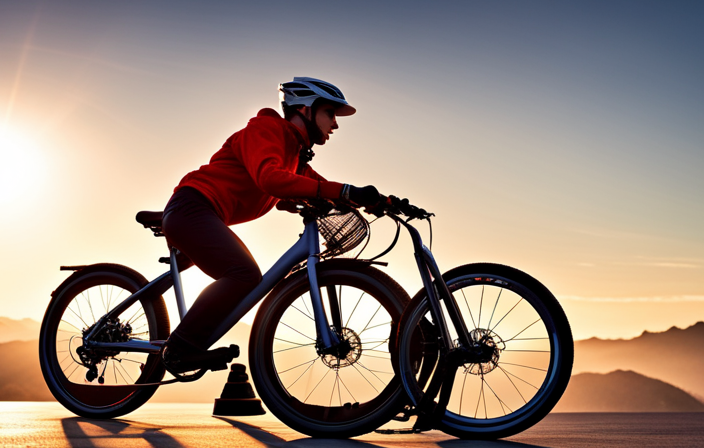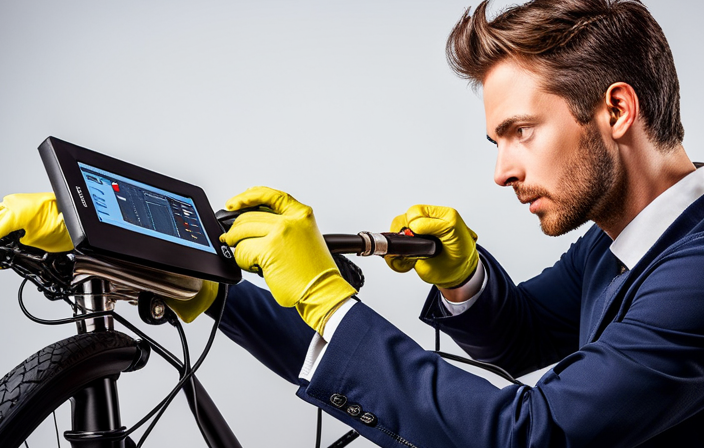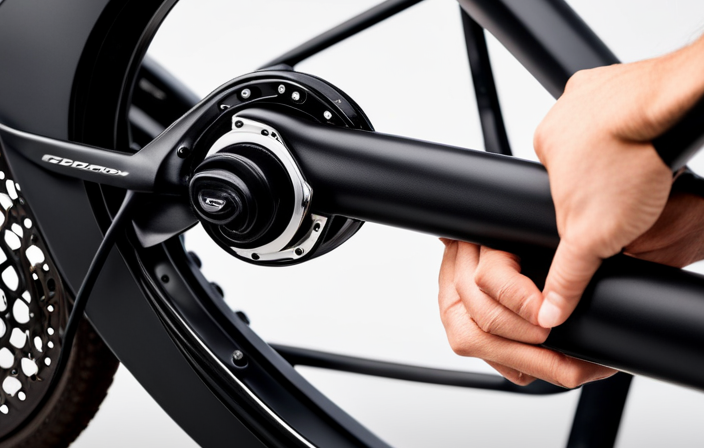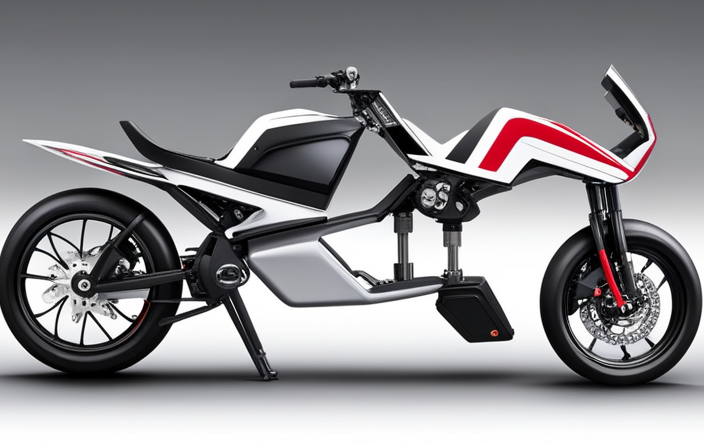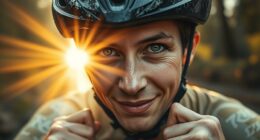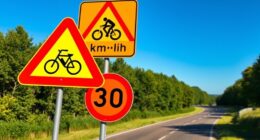Looking to experience the exhilaration of cruising at a blistering 50mph on your very own electric bike? Look no further!
In this detailed guide, I will walk you through the step-by-step process of building your own high-speed electric bike.
From understanding the legal requirements to selecting the right components and fine-tuning the performance, I will provide you with all the technical knowledge and analytical insights you need to create your own two-wheeled speed machine.
So, let’s dive in and unlock the thrilling potential of your electric bike!
Key Takeaways
- Regular maintenance is crucial for ensuring the proper functioning and longevity of the electric bike.
- Upgrading the gearing system, battery, and motor can significantly improve the bike’s performance and speed.
- Optimizing aerodynamics through frame redesign and incorporating aerodynamic elements can enhance overall efficiency and increase speed.
- Testing, fine-tuning, and adhering to safety regulations are essential steps in building a 50mph electric bike.
Introduction to Electric Bikes
If you want to build a 50mph electric bike, you’ll need to start by understanding the basics of electric bikes.
Electric bikes, also known as e-bikes, are becoming increasingly popular due to their numerous advantages. One of the main advantages is the ability to travel at higher speeds without much effort. However, there are also some drawbacks to consider. For instance, electric bikes tend to be more expensive than traditional bikes, and their range can be limited depending on the battery capacity.
When it comes to the types of electric bike motors, there are mainly two categories: hub motors and mid-drive motors. Hub motors are located in the wheel hub, providing direct power to the wheel. On the other hand, mid-drive motors are positioned near the bike’s pedals, offering a more balanced and efficient power delivery.
Understanding the pros and cons of electric bikes and the different types of motors is crucial for building a high-speed electric bike.
Now, let’s delve into understanding the legal requirements and regulations.
Understand the Legal Requirements and Regulations
To understand the legal requirements and regulations, you need to research and familiarize yourself with the specific rules in your area. Understanding legal restrictions is crucial when building a high-speed electric bike.
Different regions have different laws regarding the maximum speed, power output, and classification of electric bikes. Some places may require registration, insurance, and a valid driver’s license to operate a high-powered electric bike on public roads. Ensuring compliance with regulations is essential to avoid legal issues and penalties.
Make sure your electric bike meets the required standards for safety, emissions, and noise levels. It is also important to check if any modifications or additional equipment, such as lights or mirrors, are necessary to comply with local regulations.
By thoroughly researching and understanding the legal requirements, you can build an electric bike that is both fast and legally compliant.
Moving on to the subsequent section about choosing the right frame and components…
Choose the Right Frame and Components
When choosing the frame and components, make sure to consider your specific needs and preferences.
There are several customization options for the frame that you should take into account. First, consider the material of the frame, such as aluminum or carbon fiber, as this will affect the bike’s weight and durability. Additionally, think about the frame’s geometry, including the size and shape, to ensure a comfortable riding experience.
Secondly, when selecting the right components, keep in mind factors such as the type of brakes, gears, and suspension system. These choices will impact the bike’s performance and handling. It’s crucial to choose high-quality components that are compatible with the frame and will withstand the increased speed.
Moving forward, the next step is to select the motor and battery system to power your electric bike.
Select the Motor and Battery System
To select the motor and battery system, consider your power and range requirements.
When it comes to motor selection, you need to look at factors such as power output, torque, and efficiency. A high wattage motor will provide more power, allowing you to reach higher speeds. Additionally, torque is important for accelerating quickly and climbing steep hills.
As for battery capacity, it determines the range you can achieve on a single charge. A larger capacity battery will allow you to travel longer distances without needing to recharge.
It’s also crucial to consider the weight and size of the motor and battery, as they will have an impact on the overall balance and handling of the bike.
With the motor and battery system chosen, it’s time to move on to installing them on the bike, ensuring a seamless integration for optimal performance.
Install the Motor and Battery on the Bike
Now that I’ve selected the motor and battery system, it’s time to install them on the bike for optimal performance. Choosing the right motor and battery size is crucial for achieving the desired speed of 50mph. The motor should have enough power to propel the bike at high speeds, while the battery needs to provide sufficient energy to support the motor’s operation.
To properly install the motor and battery, I’ll need to follow the manufacturer’s instructions carefully. This typically involves attaching the motor to the bike frame using mounting brackets and securing the battery in a suitable location, such as the center of the frame or the rear rack.
In order to ensure proper installation and wiring, I will refer to the wiring diagram provided with the motor and battery system. This diagram will guide me in connecting the wires correctly, avoiding any potential short circuits or electrical hazards. Once the motor and battery are securely installed and wired, I can move on to the next step: connecting the wiring and testing the electrical system to ensure everything is functioning as expected.
Connect the Wiring and Test the Electrical System
First, make sure you securely connect the wiring and test the electrical system to ensure everything is functioning properly.
Testing procedures are crucial to guarantee the safety and efficiency of your electric bike. Start by carefully inspecting the connections between the motor, battery, and controller. Ensure that all wires are properly connected, and that there are no loose or exposed wires that could cause a short circuit.
Once the wiring is secure, proceed to test the electrical system. Turn on the bike and check if the motor engages smoothly and accelerates without any issues. Test the brakes and ensure they respond effectively, as safety is of utmost importance. Finally, verify that all lights and indicators are working correctly.
Once you have confirmed the functionality of the electrical system, you can proceed to upgrade the brakes and suspension for increased safety.
Upgrade the Brakes and Suspension for Increased Safety
Upgrading the brakes and suspension will enhance the safety of your ride. When building a 50mph electric bike, it is crucial to have a brake system that can handle the increased speed and stopping power.
Consider upgrading to high-performance disc brakes, which provide better stopping power and heat dissipation compared to traditional rim brakes. Additionally, upgrading the suspension will improve your bike’s stability and handling, especially when riding at higher speeds. Look for suspension upgrades that offer adjustable damping and preload settings, allowing you to fine-tune the suspension to your specific riding conditions.
Upgrading the brakes and suspension will give you more control over your bike and reduce the risk of accidents. With the enhanced safety measures in place, you can now move on to the next step: installing a high-speed controller for enhanced performance.
Install a High-Speed Controller for Enhanced Performance
Installing a high-speed controller will significantly improve your bike’s performance. When it comes to installation, there are a few tips to keep in mind.
First, ensure that you choose a controller compatible with your bike’s motor and battery system. This will ensure optimal performance and prevent potential issues.
Make sure to follow the manufacturer’s instructions carefully during the installation process. Troubleshooting common issues with high-speed controllers can be done by checking wiring connections, ensuring proper voltage, and inspecting for any loose connections.
Regularly maintain and clean your controller to prevent dust and debris buildup. This will help prolong its lifespan and ensure it functions properly.
With a properly installed high-speed controller, you can expect enhanced acceleration and overall performance.
Moving on to the next section about upgrading the gearing system for improved speed, it’s important to consider the different options available.
Upgrade the Gearing System for Improved Speed
To improve speed, consider upgrading the gearing system on your bicycle. The gearing system plays a crucial role in determining the bike’s acceleration and overall performance. By upgrading the gears, you can enhance the bike’s ability to transfer power from the motor to the wheels, resulting in improved speed and acceleration.
Here are a few key considerations when upgrading the gearing system:
- Choose a gear ratio that is optimized for high-speed performance.
- Install a lightweight, high-quality chain to reduce friction and power loss.
- Upgrade the derailleur to ensure smooth and precise shifting, allowing for efficient power delivery.
By upgrading the gearing system, you can significantly improve your electric bike’s speed and acceleration.
In the next section, we will explore how to optimize the aerodynamics of the bike to further enhance its performance.
Optimize the Aerodynamics of the Bike
To further enhance the speed of our electric bike, we have already upgraded the gearing system. However, in order to achieve our goal of reaching 50mph, we must also optimize the aerodynamics of the bike.
By improving the bike’s aerodynamic profile, we can reduce wind resistance and improve stability, ultimately allowing for higher speeds. One way to achieve this is by redesigning the bike’s frame to have a more streamlined shape, reducing drag. Additionally, we can incorporate fairings and aerodynamic elements, such as a streamlined seat and handlebars, to further reduce turbulence and improve overall efficiency.
By focusing on optimizing the aerodynamics of the bike, we can significantly improve its speed and performance.
Next, we will explore how to enhance the battery range and efficiency, ensuring that our electric bike remains capable of maintaining these high speeds.
Enhance the Battery Range and Efficiency
One way to improve the battery range and efficiency is by optimizing the power consumption of the components. Battery charging techniques play a crucial role in maximizing the range of an electric bike. Utilizing smart charging methods, such as implementing a proper charging schedule and avoiding overcharging, can significantly extend the battery life and enhance its efficiency.
Additionally, using energy-saving tips can contribute to a longer battery range. For instance, reducing the weight of the bike by using lightweight materials, minimizing friction by employing high-quality bearings, and optimizing the gear ratio can all help to reduce power consumption and increase the overall efficiency of the bike.
By implementing these battery optimization techniques and energy-saving tips, the electric bike can achieve a longer battery range and improve its overall performance. With the battery range and efficiency optimized, the next step is to test and fine-tune the bike for optimal performance.
Test and Fine-Tune the Bike for Optimal Performance
You can now test and fine-tune your bike for optimal performance. Fine-tuning techniques are crucial to ensure your electric bike reaches its maximum potential.
To begin, conduct performance testing methods such as speed tests and acceleration tests. Measure the bike’s top speed and evaluate its ability to reach that speed quickly. This will help identify any areas that need improvement.
Additionally, analyze the bike’s handling and stability by taking it for a test ride on different terrains. Adjust the suspension and tire pressure as necessary to enhance the bike’s overall performance.
Fine-tuning the motor and controller settings can also optimize power delivery and efficiency. Experiment with different settings to find the perfect balance.
By fine-tuning your bike, you can improve its performance and make it more enjoyable to ride.
Moving forward, it is important to ensure proper maintenance and safety measures are in place to keep your electric bike running smoothly and safely.
Ensure Proper Maintenance and Safety Measures
Make sure to regularly maintain and follow safety guidelines for your e-bike to ensure its longevity and your safety. Proper maintenance is essential for keeping your electric bike running smoothly and preventing any potential issues. Here are some maintenance tips to keep in mind:
- Regularly check the tire pressure, chain tension, and brake pads to ensure optimal performance.
- Keep the battery charged and clean to maximize its lifespan.
- Clean the bike regularly, especially after riding in muddy or dusty conditions, to prevent dirt buildup and corrosion.
- Inspect the electrical components for any loose connections or damage.
Additionally, investing in safety equipment is crucial for your well-being. Wear a helmet to protect your head in case of accidents, and consider using knee and elbow pads for extra protection. Incorporating these maintenance tips and safety measures will ensure a smooth and safe ride. Remember to ride responsibly and observe traffic laws to further enhance your overall biking experience.
Ride Responsibly and Observe Traffic Laws
When riding your e-bike, it’s important to ride responsibly and obey all traffic laws. Riding etiquette and safety gear play a crucial role in ensuring a safe and enjoyable experience. Here are four key points to keep in mind:
-
Maintain a proper distance: Always maintain a safe distance from other vehicles on the road. This will give you enough time to react to any sudden changes in traffic.
-
Signal your intentions: Use hand signals to indicate your turns and lane changes. This will help other drivers anticipate your next move and avoid any potential accidents.
-
Wear safety gear: Always wear a helmet, protective clothing, and reflective gear to increase your visibility and protect yourself in case of a fall or collision.
-
Follow speed limits: Adhere to the speed limits and adjust your speed according to road conditions. Remember, your high-speed electric bike requires extra caution.
By following these guidelines, you can safely enjoy the thrill of your high-speed electric bike.
Enjoy the Thrill of Your High-Speed Electric Bike
Experience the exhilaration of riding a high-speed e-bike and feel the wind rushing through your hair as you cruise along the open road.
To achieve the thrilling speeds of a 50mph electric bike, certain modifications are necessary. Firstly, upgrading the motor and battery system is crucial. A high-performance motor with increased wattage and torque will provide the power needed for high speeds. Additionally, a larger capacity battery will ensure longer range and consistent performance.
However, it is important to note that speed limit restrictions must be adhered to. Always check local laws and regulations regarding e-bike speed limits, as exceeding these limits can result in fines or legal consequences.
It is also crucial to ride responsibly and consider the safety of yourself and others. Enjoy the thrill of your high-speed electric bike, but remember to always prioritize safety and follow the rules of the road.
Frequently Asked Questions
How much does it cost to build a 50mph electric bike?
Building a 50mph electric bike can cost around $2000-$5000, depending on the components used. The cost includes components like a high-power motor, lithium-ion batteries, a controller, and a robust frame to handle the speed.
Are there any weight restrictions for the rider when using a high-speed electric bike?
Weight restrictions are crucial for safety when riding a high-speed electric bike. Exceeding the maximum weight limit can compromise stability and control, leading to accidents. It’s imperative to adhere to these restrictions for a safe and enjoyable riding experience.
Can I ride a 50mph electric bike on public roads?
I can ride a 50mph electric bike on public roads, but there are safety regulations and insurance requirements to consider. It is important to comply with local traffic laws and ensure adequate insurance coverage to protect myself and others.
How long does it take to charge the battery of a 50mph electric bike?
The charging time of a 50mph electric bike depends on the battery capacity. With a 10Ah battery, it takes around 2.5 hours to fully charge. However, with a larger 20Ah battery, it may take up to 5 hours.
Is it difficult to control and balance a high-speed electric bike at such high speeds?
Controlling and balancing a high-speed electric bike at 50mph requires advanced skills and adherence to safety measures. Proper body positioning, smooth throttle control, and quick reflexes are essential for maintaining stability and preventing accidents.
Conclusion
So there you have it, folks! After hours of research, careful planning, and meticulous execution, I’ve successfully built my very own 50mph electric bike.
With its powerful motor, top-of-the-line components, and sleek frame, this beast of a machine is ready to take on any road or trail.
I can already feel the wind rushing through my hair as I zoom past cars and leave them in the dust. It’s like flying on two wheels!
But remember, safety first – always wear your helmet and follow traffic laws.
So hop on and experience the exhilaration of riding a high-speed electric bike like never before!
